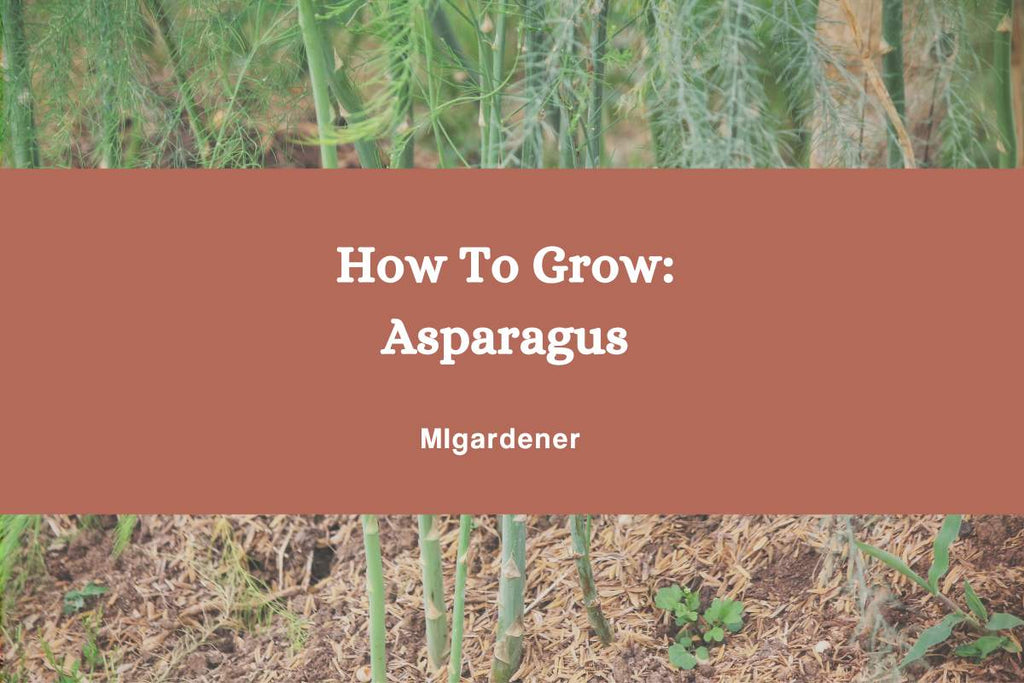
How to Grow: Organic Perennial Asparagus
When properly planted, asparagus can be one of the hardiest and longest to last vegetables in the garden. These perennial plants can grow up to 40 years old and only get larger each year. Crowns at full maturity can produce 9-13 spears! Follow this simple growing guide to learn the simple ways to plant asparagus to harvest for years to come. Asparagus can be planted in two types; seed and rhizome. We carry both, but the rhizomes can only be sold during the early spring during their dormant stage. You can find our varieties here.

Here's how to start:
Soil Prep:
Because we want to grow asparagus as a perennial, it's important to plant from seed in loose soil. Asparagus loves sandy well-drained soil. Combine a 50/50 mix of sand and compost to prepare the perfect soil. You should amend and thoroughly fertilize soil once before planting. Amending and fertilizing every year would involve disrupting the crown and roots of the plant and is not recommended. In order to properly establish the deep root system needed for it to produce a harvest year after year, till the soil a foot deep. This way, the soil can insulate the plant through frost and winter. Ph should be neutral ( between 6.5-7.5)
- Growing in pots is not recommended - this doesn't allow for proper insulation during cold harsh winters.
Fertilizing:
Asparagus prefer a nitrogen rich soil, but also require adequate amounts of phosphorus for good root development. Because Asparagus are perennial, this means they have an aggressive root system that moves quickly throughout the soil in order to establish itself before winter. Phosphorus is responsible for root development. Asparagus is actually the young shoots of the asparagus fern, and this requires Nitrogen to promote green growth. Plants should be fertilized 2 times per year, once in spring to pull the plant out of dormancy, and once in the fall before the plant goes dormant to establish the roots before winter.
Watering:
Plants prefer moist and well watered soil. Their natural habitat is sandy loam beaches and ditches where drainage is adequate but irrigation is plentiful. Plants should be mulched to ensure good soil moisture during summer heat. Plants should also be kept from being waterlogged by making sure soil is at least 40% sand and 20% organic matter.
Sunlight:
Asparagus requires 6-8 hours of sunlight. If you are planting in a space that leans on the sunnier side, make sure to apply mulch throughout the year to protects the soil from drying out between watering. Asparagus will grow wild in areas that have heavy overhead foliage. They thrive in ditches, beaches, and along bluffs where the water comes from runoff and gathers, but also the surroundings provide protection from the hot sun. This means Asparagus can grow in a wide variety of growing conditions in your garden.
Planting:
Dig a trench for planting, place plant or rhizome in and cover with soil, lightly pat down once covered. Plant 8-12 inches apart.

From plant: 6" deep trench
From rhizome: 10-14" trench
Water with compost tea to fertilize and heavily mulch around the crown in order to keep weeds from interrupting the growing process.
Harvesting:
The problem that most people have with asparagus is that they are too eager to harvest in the first year! Do not harvest in the first year. Patience is key when it comes to harvesting asparagus. With patience, your plants will be able to establish hardy and deep rooting systems and will eventually produce multiple shoots of asparagus per crown. After three years of establishing, you'll be able to harvest twice a year for up to fifteen years!

To harvest, snap off 8-10 inch long spears less than 1 inch in diameter before the buds open. Leave spears smaller than a pencil to grow. Harvesting season starts in May and continues through June in most regions. Make sure to complete the harvest before July 1st. Do not cut the ferns that grow after harvesting until they are completely dead in the fall or just before growth begins in the spring to avoid damaging the crown.

More information can be found on our Youtube Asparagus playlist.
Written by - Kaitlynn from MIgardener
_________________________________________________________________
Did you enjoy this post? MIgardener is passionate about sharing free gardening tips and information! If you are looking for inspiration in the garden, make sure to check out our Pinterest page. Check us out at MIgardener.com or on youtube, Instagram, and Facebook.
My crowns arrived today. I can’t get to planting them for a few days…should I soak them, or put them in damp coconut whatever-it’s-called, the fiber stuff…? Can’t seem to find any info on this on the internet. Thanks.
Should I remove the asparagus seedlings that sprout in my bed and just maintain the original planted roots?
How do I grow from seed?
In Wisconsin.
Thanks!
I need to move my bed. When can I transplant? Saved seed from las year and want to start some new plants. When to start.
Question: why do some of my 4 yr old asparagus have red bulbs on the ferns and some do not?
Can more asparagus seeds be added to my existing raised bed of asparagus without harming the established crowns? If so how?
Thank you!
Leave a comment